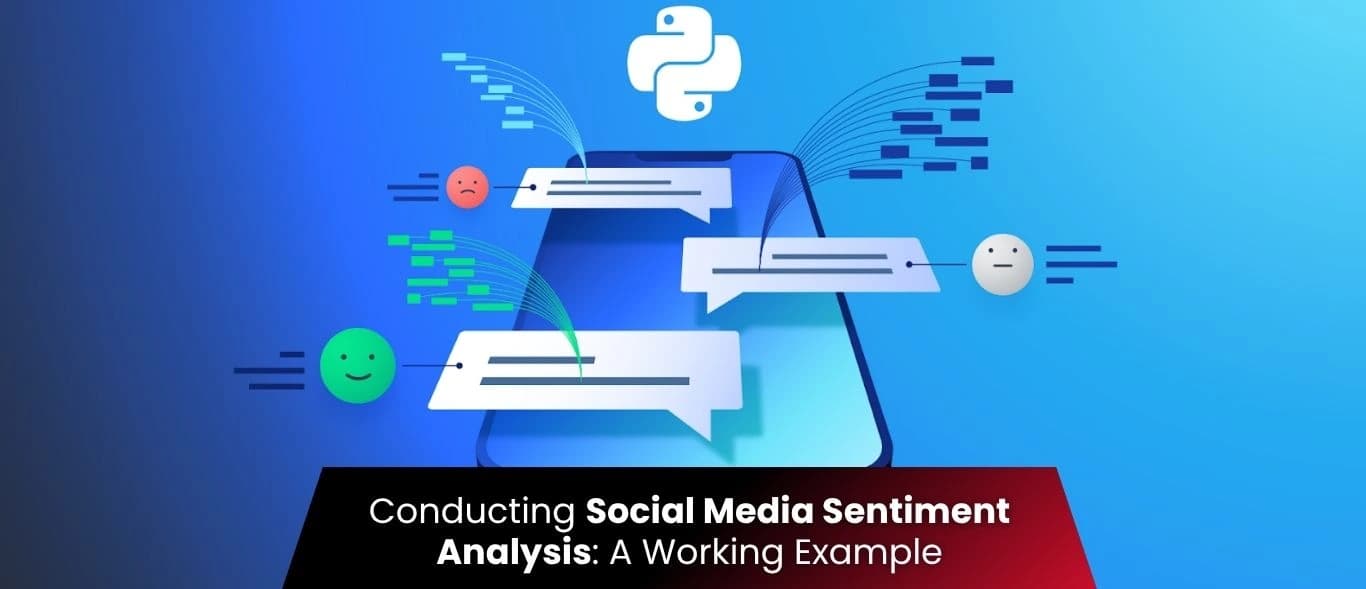Sentiment Analysis: Before we launch into why conducting social media sentiment analysis of your brand on social media is essential, and how to go about doing sentiment analysis with Python, here’s a quick lowdown on sentiment analysis itself with a working example.
Why is Sentiment Analysis Important
Why is sentiment analysis critical for businesses? Till a few years ago, analyzing a customer’s sentiments was not something that was taken seriously. Today, thanks to advancements in technology and business thinking, sentiment analysis is emerging as a viable tool.
What makes it interesting and distinct from other forms of data analytics is that this one deals with emotions, and as we all know, emotions are never black or white.
Express Analytics puts the voice of the customer at the heart of the business. Want to learn more about sentiment analysis using Python? Please fill out this short form, and our experts will be in touch with you.
Sentiment analysis reveals to a brand or enterprise what the world or its consumers feel about it. The sentiments could be positive, negative, or even neutral.
Sentiment analysis is an algorithm-driven process, with the algorithms having access to a dictionary of words, each of which holds a positive, negative, or neutral sentiment.
Example: happy, sad, annoying, rewarding, lovely, wonderful, creative, etc.
To conduct such an analysis, a business must have the necessary tools in place and a clear understanding of how to utilize them.
What Is Social Media Sentiment Analysis?
As the name suggests, it means just that – to understand what people feel or think about your product, service, or even brand.
Today, this has gone beyond vanity metrics , such as likes, and mentions
Social media sentiment analysis involves collecting and analyzing information from posts that people share about your company on social media.
Why is this form of analysis important? You get to know exactly what people think of your brand on social media.
What are they saying? Are the majority happy or unhappy with your product? Why? Social media sentiment analysis helps you answer these types of questions.
Increasing Use of AI in Sentiment Analysis
Due to advancements in Natural Language Processing (NLP), data analysts can now segment client feedback as positive, negative, or neutral using natural language.
NLP was mainly being used in text analytics. With NLP, this form of analytics categorizes words into a predefined structure before extracting meaning from the text content.
NLP is used to derive changeable inputs from the raw text for either visualization or as feedback to predictive models or other statistical methods.
However, with the advent of new technology, there are sentiment analytics vendors that now offer NLP as part of their business intelligence (BI) tools.
For example, from the text, NLP is now used to make sense of “voice” in interfaces such as digital voice assistants or smart speakers like Amazon’s Alexa, as the latter become increasingly interactive.
What is Sentiment Analytics?
In sentiment analytics, to get a relevant result, everything needs to be put in a context or perspective. When a human uses a string of commands to search on a smart speaker, for the AI running the smart speaker, it is not sufficient to “understand” the words.
It also needs to bring in a context to the spoken words used, and try and understand the “searcher’s”, eventual aim behind the search.
What keeps happening in enterprises is the constant influx of vast amounts of unstructured data generated from various channels – from interactions with customers or leads to social media reactions, and so on.
Now, to make sense of all this unstructured data, you require NLP, which gives computers the wherewithal to read and obtain meaning from human languages.
Benefits of Sentiment Analysis for Businesses
Companies can use sentiment analysis to identify their customers’ moods. By knowing the mood of your consumers, you can create products or provide services that will appeal to them.
For example, if your customers are unhappy about the economy, you can use this knowledge to create loyalty campaigns and new products.
Companies utilize sentiment analysis to enhance customer service, develop more effective products, and assess the overall satisfaction of their customers.
For example, if you analyze the ratings and reviews of your product and service and find that they’re overwhelmingly positive, it could indicate that there’s a good chance that people would be happy with it.
However, if your customers are overwhelmingly negative, it may indicate that there are some issues with the product or service.
The sentiment analysis tool scores whether an article or comment has positive, negative, or neutral sentiments towards a given topic.
Sentiment Analysis Crucial for Online Reputation Management
The sentiment is crucial for online reputation management. Suppose you have a positive online reputation and want to maintain it. In that case, you must gather sentiments from your web page visits or social media channels to analyze the overall feelings your community has about your business.
Do people love what you’re doing? Are they indifferent or disappointed? It doesn’t matter how perfect your product or service is if no one knows about it!
If your company’s reputation is being damaged by nasty comments on Facebook, Twitter, or other social media outlets, you need to rectify that at the earliest.
What’s more, sentiment analysis is also a powerful marketing tool, as it helps determine customer emotions in a particular marketing campaign.
Reasons Why Every Business Needs to Do it Right Now
With social media becoming a vital aspect of marketing for businesses of all sizes, finding the best ways to analyze the online buzz surrounding a brand has become a new skill set.
Sentiment analysis is the process of determining the sentiment expressed in a text.
It may be used to determine the emotions a group of words conveys, such as how positive or negative a person is perceived to be. In text mining, automatic sentiment analysis can help determine if a message is positive or negative.
Sentiment analysis is the process of determining whether a piece of writing is positive, negative, or neutral.
For example, if your post appears to be getting a lot of likes and shares, you can assume that your content is generally appealing to consumers.
If you find that your post is receiving a lot of dislikes and shares, then the chances are that you should take action to address this issue.
Here are some other use cases in business:
To upsell
You might be well aware of the benefits you offer customers, but what about those customers who have not yet discovered them?
This can be achieved through positive-sentiment-based offerings, where the company provides more of the same product or service that existing customers are already using.
This technique is effective for companies that have excellent reviews on their products or services but are unsure of their brand perception among new customers.
To improve customer service
Just as a good relationship between a customer and a company grows over time, so does its influence on business growth.
A well-developed customer care system can help in strengthening such a relationship. The benefits of such a customer care system include:
Improved customer satisfaction: Identifying common customer grievances and enhancing the business’s capability to serve those needs.
The process begins with identifying the needs of individual customers, followed by identifying the business’s operational shortcomings.
With the information acquired from the analysis, businesses can enhance their operations by revamping existing systems and processes, hiring additional personnel, or developing new infrastructure to serve their customers better.
For new marketing strategies
In today’s competitive market, businesses have to have a thorough understanding of their target audience.
Market research results from the customer care database can help in uncovering exactly how customers interact with a business.
The company’s use results could lead to a complete market-tailored solution.
A study of customer needs and behaviors, including how customers use a product or service, their preferences, and demographics, can help a business formulate effective marketing plans for optimal sales.
Sentiment analysis to find and encourage social networks and engage with their customers.
For example, if a company has a Facebook page, it can analyze the likes and shares of its posts and determine how often people engage with them.
To tackle a crisis
Companies must be able to respond quickly to changes in their customer base.
Analysis of what is happening with a particular customer can help to create better responses and prevent customer loss or damage caused by delayed action.
On the other hand, investing resources in branding when no real change or apparent problems occur will only mean that they are wasting money without gaining anything in return.
Want actionable insights that increase customer experience and conversions? -- Let's Talk
Sentiment Analysis Use Cases
Product review sentiment classification: When applied to review sentiment classification, the features or labels can be classified as polarities or not.
If the analysis requires classification into negative and positive categories, this is referred to as a binary classifier.
If the analysis requires classification into dark and light categories, this is known as a sentiment polarity classifier.
Track customer sentiment over time: The application of a linear model in review sentiment analysis is the most effective method for extracting trends between customer sentiment and time.
By finding the correlation coefficient between review sentiment and time, we can identify customer sentiment trends by determining the point at which the correlation coefficient is the highest.
This process will reveal how customers’ sentiments evolve.
Customer Sentiment Analysis models are used in almost every industry, including travel, banking, e-commerce, food delivery, and many more.
Sentiment Analysis Algorithm Types
Sentiment analysis can be achieved using different approaches, each with its own benefits and drawbacks.
Here are the most popular types:
- Supervised learning
- Unsupervised learning
Supervised learning: Supervised learning is the most common approach for sentiment analysis.
It relies on the existence of feature vectors that are applied to the training data before the classifier is trained.
These features consist of numerical descriptions for each message sent by customers, which are used as input into a series of statistical calculations that determine how a given sentence should be classified as positive or negative.
This process is then repeated until all the data has been processed.
Unsupervised learning: Unlike supervised learning, in unsupervised learning, no pre-defined feature vectors are used.
Instead, models learn from the data itself and calculate features automatically using regression techniques or cluster analysis. This results in better classification accuracy because it does not rely on human-provided labels to make decisions.
In other words, it avoids the dependence on knowledge of the label set.
How to Conduct Social Media Sentiment Analysis Python (with Twitter as an Example)
How to do Twitter sentiment analysis in Python? Here’s an example of sentiment analysis.
The process of sentiment analysis in Python, by and large, can be duplicated across almost all social media networks (Twitter). Data scientist Shubham Shankar shows you the way. You need to start by:
Understanding Your Market
Any Python-based sentiment analysis begins with understanding your audience.
This means you need to understand how your audience feels about not only your brand but also your various marketing campaigns.
Choose The Right Keywords, Hashtags, And Labels
Your business needs to choose specific keywords that sentiment analysis software detects, like:
- It’s great or it’s wonderful
- It’s cheap or it’s expensive
- It’s easy to use or
- I didn’t like it
Then, you need to assign a sentiment score to each of these words. Obviously, it means that positive feedback receives a higher sentiment score, while negative feedback receives a lower one.
Want actionable insights that increase customer experience and conversions? -- Let's Talk
Two Techniques of Sentiment Analysis
Before going ahead with this post on sentiment analysis with Python, you must understand that there are two techniques for this form of sentiment analysis.
Rule-based
Very simply put, this method utilizes a dictionary of words labeled by sentiment to determine the sentiment expressed in a sentence.
As mentioned above, after a sentiment score is assigned, it must be combined with additional rules.
Machine learning-based
This eliminates most human interaction. In this technique, an ML algorithm is trained to recognize the thought based on the words and their order using a labeled training set.
The technique is dependent on the type of algorithm and the quality of the training data. The “label” will be a measure of how positive or negative the sentiment is.
Sentiment Analysis of Twitter with Python
How to do sentiment analysis on Twitter data using Python step by step (sentiment analysis Python)? To fetch real-time data from Twitter, we first need to obtain our key and access token using the official Twitter API Tweepy from the Twitter Developer Tool website.
Once we have the keys, we can proceed toward tweet extraction and creating the sentiment model.
By Importing Necessary Libraries
We have to import all the required libraries.
Getting Credentials
To extract tweets from Twitter, we need to fill in the consumer_key, consumer_secret, access_key, and access_secret, and then initialize the API as shown.
Before we start extracting the tweets, we must define the usernames of the accounts for which we want to analyze the tweets. We can also define query words related to what we wish our tweet data to be.
Here, we will analyze the tweets from the official Twitter accounts of five global organizations.
Extracting Tweets from Twitter using Python
Now that we have defined the organizations, we are ready to extract the tweets. Using the code below, we extract 100 tweets from each organization’s Twitter feed and store all the tweets in the sentiment dictionary, along with the user and the date the tweet was posted.
The tweets data is in the dictionary, and we convert it into a data frame for further processing. Now you can see the data pulled from Twitter, including tweets, users, and posts by date.
Cleaning the Twitter data
In this post, we discuss conducting sentiment analysis using Python with a Twitter example.
Well, we fetched real-time tweets from Twitter, but now we have to extract meaningful insights from the data in the tweets. For that, we need to clean the data because it contains numerous URLs, numbers, and user IDs, which makes it challenging to analyze the tweets.
What is the VADER Sentiment Analysis Model
VADER (Valence Aware Dictionary for Sentiment Reasoning) is a model used for text sentiment analysis that is sensitive to both polarity (positive/negative) and intensity (strength) of emotion.
Well, VADER sentiment analysis relies on a dictionary that maps lexical features to emotion intensities known as sentiment scores.
The sentiment score of a text can be obtained by summing up the intensity of each word in the text.
Vader takes in a string and returns a dictionary of scores in each of four categories:
- negative
- neutral
- positive
- compound (computed by normalizing the scores above
Using VADER Sentiment Analysis
VADER is available in the NLTK package and can be applied directly to unlabeled text data as shown below.
After initializing the analyzer, we can use polarity_scores() to find all the positive, negative, and neutral scores for each tweet.
Now, using the compound score, we will assign a sentiment label to each tweet.
Conclusion
VADER classifies the sentiments very well. The ready-made model can be applied to multiple domains, including media, review texts, and more. It also does not require any training data and is very easy to use.


